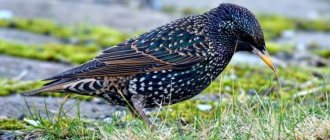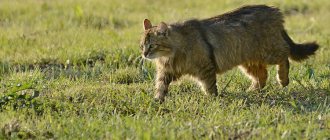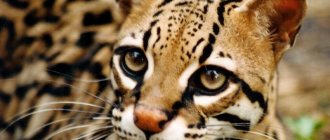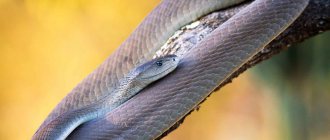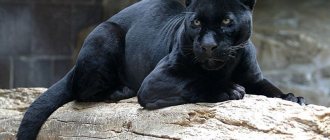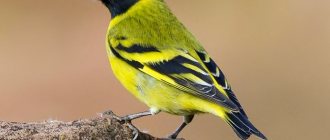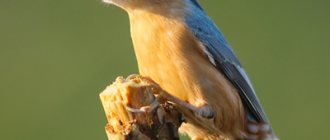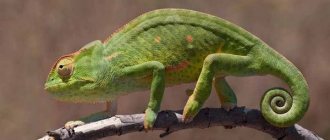Description
The length of the body of an adult is 1000-1300 mm, the length of the tail is about 800-1000 mm and is equal to approximately 75% to 90% of the total body length. This extremely long tail is used for balancing in the rocky and mountainous terrain where they live, and the animals also use it to keep their limbs warm during harsh winter weather. The average weight of an adult snow leopard is 35-45 kg. There is no pronounced sexual dimorphism among these animals, but males may slightly exceed females in weight. Compared to other felines, snow leopards have slightly larger front paws, with an average foot pad measuring 90 to 100 mm in length and 70 to 80 mm in width. They also have relatively long hind legs, adapted for better maneuvering and jumping in their habitat.
The fur color of the snow leopard varies from light gray to smoky gray, with a creamy yellow and white tint usually found on the belly. The entire body of the snow leopard is covered with gray-black spots, which are surrounded by black rings. Larger spots and rings surrounding them are found only on the body and tail, while solid spots are common on the head, neck and lower limbs. Juveniles have longitudinal black stripes running along the back from head to tail. As they grow and mature, these stripes break up into large spots that form lateral rows of elongated rings along the center of the back.
Snow leopards have long, thick fur that sheds twice a year. In winter it becomes thicker and longer. In summer, the length of the snow leopard's fur is about 25 mm on the sides and approximately 50 mm on the belly and tail. In winter, the fur reaches 50 mm on the sides, from 30 to 55 mm on the back, 60 mm on the tail and up to 120 mm on the belly. In addition to their thick fur, they have small, rounded ears that help minimize heat loss in cold conditions. Compared to other felines, snow leopards have much larger nasal cavities, as well as small and wide heads in relation to their body size.
Dimensions and appearance
The snow leopard is a large, graceful cat. Externally, the snow leopard is similar to a leopard, but differs in its stockier body, longer tail and fur. The length of the body including the head is approximately 1-1.4 meters, the length of the tail is about 0.9-1.1 meters, that is, the tail of the animal is more than 3/4 of the length of the body. The tail is covered with long hair, so it visually appears very thick. The thickness of the tail is almost equal to the circumference of the animal's forearm. The tail helps the predator maintain balance when jumping.
Males are larger than females. The average weight of a male is about 45-55 kg, the female weighs on average from 25 to 40 kg. The height of the animal at the withers is about 60 cm.
The paws are wide and massive, but short relative to the body. The snow leopard has retractable claws, so it leaves behind round tracks without claw marks. The head of the animal is small relative to the size of the body, round. Small rounded ears without tassels at the ends; in winter, due to the thick fur, they are practically invisible. The animal has long whiskers (whiskers), black or white, up to 10.5 cm long. The predator does not have a mane or sideburns.
The snow leopard has thick, soft fur. The length of the hair on the back reaches 55 cm. In terms of the thickness of its fur, the snow leopard resembles small cats, this distinguishes it from other big cats - lion, leopard, tiger, jaguar. The color is brownish-gray, without any admixtures of yellow or red. The fur on the back and upper sides is smoky. The fur on the belly, lower sides and inside of the paws is a lighter shade. The smoky shade is more pronounced in winter than in summer. Smoky gray fur with dark spots helps snow leopards remain undetected against the background of rocks, stones and snowdrifts.
Large ring-shaped dark spots in the form of rosettes are scattered throughout the skin. There are also smaller solid spots of dark gray or black. The spots on the head are smaller, those on the back and neck are larger. At the base of the back, the spots often merge with each other, forming longitudinal black stripes along the animal's spine. The tip of the tail is usually black.
Young snow leopards have more distinct spots. Females and males do not differ in color. Geographical variation in color is practically absent. This is mainly due to the small habitat of the animal.
Area
Snow leopards live over large areas of approximately 2.3 million square kilometers. They can be found on all the high mountain ranges of Central Asia. This includes the entire Himalayan mountain system, as well as areas in Bhutan, Nepal and Siberia of Russia. Snow leopards are found anywhere from the Himalayas to southern and western Mongolia and southern Russia, but 60% of the population is found in China, especially in the autonomous regions of Xinjiang and Tebet, and in the provinces of Sichuan, Qinghai and Gansu.
Snow leopard behavior
Snow leopards are characterized by a solitary lifestyle.
They stick to their large territory, where they make rounds along one route. On the territory of their possession, males allow in from 1 to 3 females. During the daytime, the snow leopard rests in its den or basks in the sun, and at dusk it goes out hunting. The snow leopard always hunts alone. It watches over its victims near watering holes, paths and salt licks, crawling from cover to its prey on bent paws. When tens of meters remain before the animal, the snow leopard makes an ambush jump and quickly overtakes the prey with jumps up to 6-7 m in length. If the snow leopard misses in a jump, then it pursues the victim no more than 300 m. It grabs large ungulates by the throat, after which it breaks the neck or strangles it. Afterwards, the snow leopard has a meal in some secluded corner. The remains of his prey usually go to vultures and other scavengers. During one meal, the snow leopard eats about 3 kg of meat.
Habitat
Steep, rocky, and rugged terrain is the preferred resting place for snow leopards, particularly near natural vegetation. The cliffs and large ridges are ideal for daytime recreation. Snow leopards live in alpine and subalpine zones at altitudes from 900 to 5,500 meters and above, but most often at altitudes between 3,000 and 4,500 meters. In winter they can migrate to lower places, to an altitude of 900 meters. Snow leopards generally avoid dense forests and cultivated fields, but can inhabit coniferous forests, as well as arid and semi-arid scrubland, grasslands, mountain grasslands and barren areas.
In western Nepal, an area with high prey densities, the average habitat range size ranges from 12 to 39 square kilometers. However, in areas with difficult terrain, the actual range is likely to be 20-30% greater.
Snow Leopard
Snow cat - this is how the second world-famous name of the leopard - snow leopard - is translated from the Turkic language. And the snow leopard is a wonderful representative of its cat family. He has a graceful gait. Its wide paws allow it to move smoothly across the surface of even the loosest and deepest snow. The length of the leopard's body including its tail reaches 2 meters. The very tail of a snow cat serves him not only for beauty, but also as a rudder when running and jumping.
Surprisingly, but true: a leopard's long jump can reach 6 meters, and its height - 3 meters. And by the way, the leopard has never been seen to be the first to attack a person.
The leopard not only has a silent gait and high camouflage in the mountain landscape, but also has an amazing distinctive feature from all cats: the leopard makes absolutely no sounds! He can neither howl, nor growl, nor meow. This property is due to the peculiarities of the structure of its larynx.
Female leopards can give birth once every two years. Kittens grow up quickly and, like all little children, love to slide down ice slides. At the age of 5-6 months, they actively participate in hunting with their mother.
Leopards are nomads. Despite the fact that they prefer a nocturnal lifestyle, sleeping soundly during the day in caves or rock crevices, they travel a lot. Their movements can cover an area of up to a thousand square kilometers.
This is the story about the snow leopard that my son prepared for school. And by the way, International Snow Leopard Day is celebrated annually on October 23. Why not talk about it on this day?
Information about the snow leopard will be continued by this scientific film - a video about the snow leopard:
Riddles about the snow leopard
But listen and consolidate your knowledge by solving riddles about the snow leopard:
Lives high in the mountains
This predatory “snow” cat.
(Leopard)
That kitty is hiding in the snowy mountains of Asia: menacing and fluffy... (Snow leopard, snow leopard)
The spotted owner of the snow-capped mountains lay down on the rocks in a gorge behind a hill, In the darkness he crawled out of a hiding place onto a rock, What is the name of the snow leopard? (Irbis).
Elegant gentleman, He lives alone in the mountains. This predatory beast is a little like a smoky cat. He will silently sneak up and return with the spoils. (Snow Leopard)
Jumping, climbing mountains He is not a coward in the slightest. White with spots. Wears a fur coat... (Snow Leopard).
Reproduction
Snow leopards are solitary animals and do not communicate with others of their own kind unless it is mating season. Due to the long time spent raising their young, females mate every second year. They are polygamous in the wild, but some snow leopards have been known to become monogamous in captivity.
Snow leopard breeding is highly seasonal and occurs from January to March. When females come into heat, they make a continuous squeaking sound that attracts males. The female offers herself to the male - she raises her tail and walks around him. During mating, the male grabs the hair on the female's neck, thereby holding her in one position. Gestation lasts 90-105 days, with cubs born from April to June. The number of offspring per litter is 2-3 kittens, but in rare cases varies from 1 to 5. They are born in rocky shelters, where the female makes a warm nest of wool on her belly. At birth, snow leopard kittens weigh between 300 and 600 grams.
Breastfeeding lasts about 5 months, but young animals can consume solid food as early as 2 months of age. The first year of life there is a close connection between the mother and her offspring. Females reach sexual maturity at 2-3 years, and males at 4 years.
Since snow leopards are solitary animals, the longest social contact occurs during the period when females are raising their offspring. Kittens are born blind and open their eyes when they reach one week of age.
The reproductive rate of snow leopards is higher in areas where females have the opportunity to hide in reliable shelter and also feed on prey nearby. This is necessary for the safety of their offspring, since inaccessible and reliable shelter helps hide the babies from other predators and allows females to hunt freely. After reaching three months of age, kittens follow their mother and learn basic survival skills such as hunting. During the first year of life, the mother provides the cubs with food, protection, training and other necessary resources.
Reproduction and offspring
The breeding season for snow leopards is in the spring. While patrolling his domain, the male begins to make special sounds, similar to a rude meow. Having heard them, the female living in the neighboring territory reciprocates, after which the pair meets on her territory. After this, the male returns to his place and no longer sees the female.
Female with kittens
The gestation period lasts 3-4 months depending on environmental conditions. An average of three kittens are born at one time. Their length is approximately 30 cm, their weight is 0.5 kg, the fur is brown and thick, strewn with spots all over the body. During the first week, the cubs are blind and lie near their mother all the time, feeding on milk. When they open their eyes, they begin to learn to walk. For the first few months, kittens do not leave the den and feed only on milk.
Later, they begin to go hunting with their mother and learn to get food. The kittens watch the female stalk her prey, and then try to repeat it. By the age of three, an adult is able to take care of itself independently. Then she leaves her mother’s den and goes in search of a future home.
Behavior
Snow leopards are most active during dawn and dusk. They are also very mobile and can move from one place to another every day and change their resting place several times during the day. Generally, they stay in one specific area for several weeks and then move to another.
Snow leopards are solitary animals, but during the mating season they are in pairs, so they share territory with each other. Individuals that are forced to share territory maintain a distance of approximately 2 km from the nearest individual. Snow leopards avoid each other by marking their paths with scratches, feces and special glands that can describe the sex and reproductive status of the individual.
They have a well-developed ability to jump high thanks to their wide paws and elongated hind legs. Snow leopards prefer to spend their time on tall structures, especially when living in captivity. A rare observation of the behavior of snow leopards in captivity has determined that the animals reduce their activity in places where people are present.
The preferred method of hunting is stalking. They then ambush their prey from higher ground, using rocky terrain and shrubby vegetation for camouflage.
Origin of the species
It was initially believed that the first ancestors of the snow leopard appeared during the Pleistocene era, which ended 11.7 thousand years ago. However, remains were later found that were between 1.2 and 1.4 million years old. This suggests that predators appeared on the planet much earlier.
The ancestors of cheetahs appeared approximately 1.5 billion years ago.
Scientists are still arguing about which family snow leopards belong to. At the moment, they are classified in the genus Uncia, which designates animals that have characteristics of large and small cats at the same time. For example, the skull structure of a snow leopard resembles that of a regular cat, but has a hyoid bone, which is characteristic of panthers.
Interesting fact : now only snow leopards belong to the genus Uncia, since they are the only creature that has the characteristics of medium-sized cats. Moreover, this classification was invented specifically for them.
Since the snow leopard resembles a leopard in appearance, they have long been considered relatives. But detailed studies have proven that they have no family ties. But the snow leopard has a clear relationship with all types of panthers. It was later proven that snow leopards appeared approximately 1.67 million years ago and descended from the ancestors of today's tigers.
Interesting: Frogs, toads, newts and proteas - description, photo and video
Some scientists have proposed dividing Uncia into subspecies, since the predator has a wide habitat. But more detailed studies have shown that at the genetic level, two snow leopards living in different places are no different and are representatives of the same species.
Communication and perception
Unlike other large cats, snow leopards do not growl. Instead, they emit a high-pitched howl, especially females during the breeding season. This sound allows females to notify males of their location and, as a rule, this happens late in the evening. Vocalizations are non-aggressive and the sound is produced through the nostrils of the animals. The presence of one snow leopard in close proximity to another produces this sound, and can be described as a greeting.
Snow leopards make high-pitched sounds and communicate their location. Their long tails are used in a number of communication functions. Animals also use tactile communication, namely rubbing the head and neck of their social partner, which indicates a peaceful mood.
Another way of communication is facial expressions. For example, when defending, they open their jaws quite wide and lift their lips to expose their fangs. However, when they are friendly, they only open their mouth without exposing their fangs, and also wrinkle their nose.
Snow leopards, like other felines, prefer to communicate through scents and other chemicals.
Interesting Facts
Do snow leopards live in groups?
Adults live alone and interact with other individuals of their species only during the breeding season. Snow leopard cubs stay with their mother for about 18 months, and then they go off to wander the vast expanses of the mountains and may never meet again.
How do snow leopards walk in deep snow?
The snow leopard's paws are furry and huge, giving these large cats the ability to distribute their weight evenly across the snow and act as snowshoes. Giant paws also help them move silently and protect their limbs from severe frosts.
How is the tail used?
The cat's thick tail helps maintain balance when overcoming narrow ridges, dangerous crevices, and hunting prey in difficult terrain. During its resting period, such a tail acts as a warm scarf, with which the animal covers itself and receives additional warmth.
Perhaps most surprisingly, snow leopards' tails are so thick because they are used to store fat, which helps them survive a possible hungry winter.
How do they cope with the cold?
The snow leopard's nose is very well adapted to cold weather - the short but wide nasal cavity warms the icy air even before it enters the lungs.
How far can he jump?
These cats can jump up to 15 meters and knock down their prey, which is even three times its own weight. An amazing fact - the snow leopard can jump 6 meters vertically.
Growl
Unlike most other cats, the leopard cannot growl because it has less developed necessary vocal cords. He is capable of hissing and meowing, just like a regular domestic cat, only much louder.
How easy are they to see?
Because they are elusive animals, people who live within their range and study them often call them "ghosts of the mountains." This big cat camouflages itself quite well with its smoky gray fur with dark streaks and spots that are perfect for blending in between rocks and mountainsides. Sometimes you can look directly at a leopard from a fairly close distance and simply not see it.
How does a leopard tolerate high altitude?
With a large, muscular chest, he takes deep breaths that help him absorb enough oxygen from the thin high-altitude air. Until recently, scientists assumed that these animals must have increased hemoglobin compared to other feline species, which would allow them to oxygenate their bodies more efficiently. But this theory has not yet been proven.
Nutrition
Snow leopards are carnivores and actively hunt for their prey. They are also opportunistic predators and will consume any meat to provide their body with the energy it needs. Snow leopards are capable of killing animals 3-4 times their weight, but if necessary they can consume much smaller prey.
The main animal that snow leopards feed on is nakhur (Pseudois nayaur). Other prey species include Siberian ibex (Capra ibex sibrica), marking goat (Capra failconeri), argali (Ovis ammon), mouflon (Ovis orientalis), Himalayan tahr (Hemitragus jemlahicus), Sumatran serow (Capricornis sumatraensis), Himalayan goral (Naemorhaedus goral), red-bellied musk deer (Moschus chrysogaster), wild boar (Sus scrofa), orongo (Pantholops hodgsonf), Tibetan gazelle (Procapra picticaudata), goitered gazelle (Gazella subgutturosa) and wild ass (Equus hemionus). Small prey includes marmots (Marmota), hares (Lepus), pikas (Ochotona), gray voles (Microtus), mice and birds.
Due to overhunting by humans, the population of wild ungulates in certain regions has declined significantly, and snow leopards have begun to prey on livestock.
Food and hunting
Snow leopards hunt blue sheep, argal, mountain goats and other animals found in their habitat. Although these powerful predators can kill animals up to three times their weight, they also eat smaller animals such as marmots and hares.
They are carnivores that actively hunt their prey, although they sometimes have to feed on carrion. One meal can even last for two weeks.
Other foods of this “mountain hunter” include Siberian mountain goats, Himalayan tahr, argali, deer, horses and camels. When snow leopards cannot find large prey, they also hunt smaller animals such as voles, marmots and pikas.
In a famous case, one snow leopard living in India ate five blue sheep, nine Tibetan woolly hares, 25 marmots, five domestic goats, one domestic sheep and about 15 birds in one year.
Threats
Snow leopards are predatory animals, so they have fewer threats from wild animals than from people. However, interspecific killing between leopards (Panthera pardus) and snow leopards can occur when competition for resources increases. Adults are also a potential threat to young animals.
In the last two decades, the population has declined by at least 20% due to habitat loss, prey, poaching and persecution. The main factor influencing population decline is human activity. Wool, bones and other body parts are of particular value to poachers. The skin is in great demand. Recently, their bones have become a popular substitute for tiger bones in Chinese medicine. Many farmers are responsible for killing snow leopards and risk losing their livestock.
Character and features
The snow leopard leads a solitary lifestyle. The only exception is females raising their grown cubs. The predator strictly adheres to the boundaries of its own territory, marking it with smell and claw marks. A male's territory may overlap with the territories of several females. If other individuals enter the territory of a snow leopard, the animal does not show aggression, regardless of gender. The size of an individual territory depends on the amount of prey, and ranges from 20 to 200 square kilometers.
The predator regularly makes detours around its territory, and chooses the same route. The detour includes pastures and watering places for ungulates. When walking, the animal prefers to move along river beds or along mountain ranges. Due to the significant length of the route, the snow leopard visits the same place only once every few days. A stable route makes the animal more vulnerable to poachers.
The snow leopard does not move well on high, loose snow, so in winter the predator either tramples permanent snow paths or moves to places with lower snow cover.
The snow leopard is active mainly at dusk, hunting more often before sunset and at dawn. During the day the animal rests and sleeps. As a lair, it usually chooses small caves, crevices in rocks, depressions in rocky piles, secluded places under an overhanging slab. A snow leopard can use the same den for several years.
Role in the ecosystem
Snow leopards are apex predators, meaning they play a key role in maintaining biodiversity in the ecosystem. They are an important indicator of environmental health and help regulate animal populations lower on the food chain.
Snow leopards can be recognized as indicator species, and this is important because it provides an opportunity to motivate the public to support ecosystem conservation. If snow leopard habitats are protected, many other animals will also have their habitats protected.
Parasites that live off the snow leopard: heartworms, toxoplasma, roundworm, fleas, ticks, strongylids, nematodes, etc.
Natural enemies of the snow leopard
Today, the snow leopard population is very low. As of 2003, it was estimated at only 4,000–7,000 individuals. In the 20th century, the species was included in the IUCN Red Book and the Russian Red Book; in many countries, snow leopards are protected. Two years ago, hunting these animals was completely banned. But poaching has not yet been eradicated and remains the reason for the decline in the number of snow leopards in the wild.
How does it reproduce
The snow leopard's rut begins with the arrival of spring. The female produces offspring every two years, bearing the cubs for more than 3 months. As a rule, 2-3 kittens are born with an average weight of half a kilogram and the size of a domestic cat.
In the first week they are blind and do not move. The mother feeds them milk until one and a half months. After six months they are already running with their mother to hunt, and after a year they begin to hunt on their own. The male leaves the female immediately after the birth of the babies and continues to live alone.
Population and species status
Based on data from the World Wildlife Fund, between 3 and a half and 7 and a half thousand of these animals currently live on planet Earth. About a couple thousand more live and breed in zoos. The decline in the population of these predators is associated with illegal hunting for the valuable fur of the animal. Therefore, the snow leopard is considered a small, rare animal that is in danger of complete extinction.
Important fact! Despite the fact that all countries where the snow leopard is found protect these animals at the legal level and hunting them is prohibited, poachers still hunt them. Since 1997, the snow leopard has been listed in the Red Book of Mongolia under the status of “very rare”, and in some countries – under the status of “endangered as a species”.
The snow leopard is also listed in Appendix I of the Convention on International Trade in Endangered Species of Flora and Fauna. Under the same wording, the snow leopard was included in the 2000 IUCN Red List. As a result of the work of environmental structures that monitor the dynamics of poaching of animal fur, it was found that the provisions for the protection of the species in almost all countries, although being implemented, are insufficient. In addition, none of the countries have adopted long-term programs that would allow the conservation of the snow leopard.
Snow leopard prince of the mountains Wildlife animals of the taiga of the Far East Red Book of rare species
